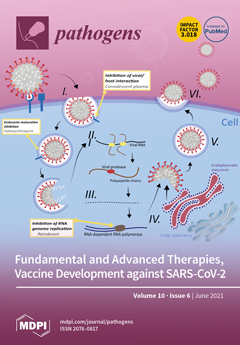Salpingitis is manifested as hemorrhagic follicular inflammation exudations and peritonitis, leading to reduced egg production and high culling of breeder flocks. From 2018 to 2021, increasing salpingitis during egg peak is threatening the poultry industry post-artificial insemination, both in breeder layers and breeder
[...] Read more.
Salpingitis is manifested as hemorrhagic follicular inflammation exudations and peritonitis, leading to reduced egg production and high culling of breeder flocks. From 2018 to 2021, increasing salpingitis during egg peak is threatening the poultry industry post-artificial insemination, both in breeder layers and breeder ducks across China. In our study,
Escherichia coli (E. coli), Enterococcus faecalis(E. faecalis) and
Chlamydia psittaci (C. psittaci) were isolated and identified from the diseased oviducts using biochemical tests and PCR. To identify and isolate pathogenicity, we inoculated the isolates into laying hens via an intravaginal route. Later, laying hens developed typical salpingitis after receiving the combination of the aforementioned three isolates (1 × 10
5 IFU/mL of
C. psittaci and 1 × 10
6 CFU/mL of
E. faecalis and
E. coli, respectively), while less oviduct inflammation was observed in the layers inoculated with the above isolate alone. Furthermore, 56 breeder ducks were divided into seven groups, eight ducks per group. The birds received the combination of three isolates, synergic infection of
E. coli and
E. faecalis, and
C. psittaci alone via vaginal tract, while the remaining ducks were inoculated with physiological saline as the control group. Egg production was monitored daily and lesions of oviducts and follicles were determined post-infection on day 6. Interestingly, typical salpingitis, degenerated follicles and yolk peritonitis were obviously found in the synergic infection of three isolates and the birds inoculated with
C. psittaci alone developed hemorrhagic follicles and white exudates in oviducts, while birds with
E. faecalis or
E. coli alone did not develop typical salpingitis. Finally, higher
E. coli loads were determined in the oviducts as compared to
E. faecalis and
C. psittaci infection. Taken together, the combination of
E. coli and
E. faecalis, and
C. psittaci could induce typical salpingitis and yolk peritonitis both in laying hens and breeder ducks. Secondary infection of
E. coli and
E. faecalis via artificial insemination is urgently needed for investigation against salpingitis.
Full article






